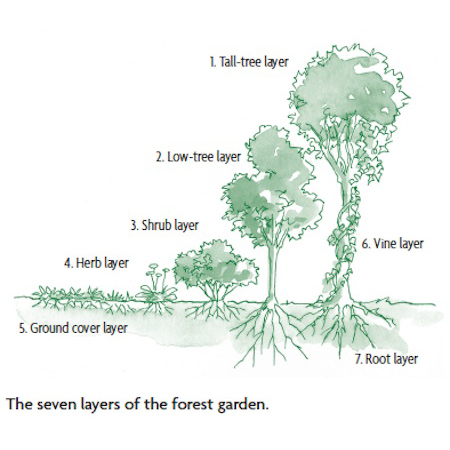
How to Design a Backyard Forest Garden
Learn how to design a lush forest garden right in your backyard with seven layers of vegetation including tall trees, low trees, shrubs, herbs, ground cover, vines, and root crops.
June 1, 2014 | Source: Mother Earth News | by Toby Hemenway
For related articles and more information, please visit OCA's Organic Transitions page and our Environment and Climate Resource Center page.
Many people mistakenly think that ecological gardening-which involves growing a wide range of edible and other useful plants-can take place only on a large, multiacre scale. As award-winning author Toby Hemenway demonstrates in Gaia's Garden (Chelsea Green, 2009), it's fun and easy to build a backyard ecosystem by assembling communities of plants that can work cooperatively and perform a variety of functions. In the following excerpt, learn how to use permaculture landscape design to create a lush seven-layer forest garden.
Buy this book from Chelsea Green:Gaia's Garden.
The Seven-Layer Forest Garden
It's time to look at forest garden design. A simple forest garden contains three layers: trees, shrubs, and ground plants. But for those who like to take advantage of every planting opportunity, a deluxe forest garden can contain as many as seven tiers of vegetation. As the illustration shows, a seven-layered forest garden contains tall trees, low trees, shrubs, herbs, ground covers, vines, and root crops.
Here are these layers in more detail.
1. The Tall-Tree Layer. This is an overstory of full-sized fruit, nut, or other useful trees, with spaces between to let plenty of light reach the lower layers. Dense, spreading species-the classic shade trees such as maple, sycamore, and beech-don't work well in the forest garden because they cast deep shadows over a large area. Better choices are multifunctional fruit and nut trees. These include standard and semistandard apple and pear trees, European plums on standard rootstocks such as Myrobalan, and full-sized cherries. Chestnut trees, though quite large, work well, especially if pruned to an open, light-allowing shape. Chinese chestnuts, generally not as large as American types, are good candidates. Walnut trees, especially the naturally open, spreading varieties such as heartnut and buartnut, are excellent. Don't overlook the nut-bearing stone piñon and Korean nut pines. Nitrogen-fixing trees will help build soil, and most bear blossoms that attract insects. These include black locust, mesquite, alder, and, in low-frost climates, acacia, algoroba, tagasaste, and carob.
Since much of the forest garden lies in landscape zones 1 and 2, timber trees aren't appropriate-tree felling in close quarters would be too destructive. But pruning and storm damage will generate firewood and small wood for crafts.
The canopy trees will define the major patterns of the forest garden, so they must be chosen carefully. Plant them with careful regard to their mature size so enough light will fall between them to support other plants.
2. The Low-Tree Layer. Here are many of the same fruits and nuts as in the canopy, but on dwarf and semidwarf rootstocks to keep them low growing. Plus, we can plant naturally small trees such as apricot, peach, nectarine, almond, medlar, and mulberry. Here also are shade-tolerant fruit trees such as persimmon and pawpaw. In a smaller forest garden, these small trees may serve as the canopy. They can easily be pruned into an open form, which will allow light to reach the other species beneath them.
